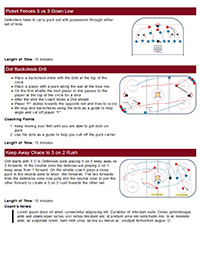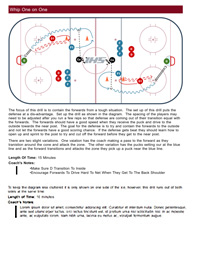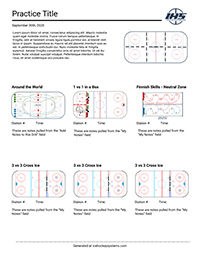Wednesday 10252023
Wednesday 10252023

Practice Notes
Our focus on tonight practice is working with speed and intention. Passing both sending and receiving passes while moving with speed.
Red Wing 2 V 1 With Backchecker
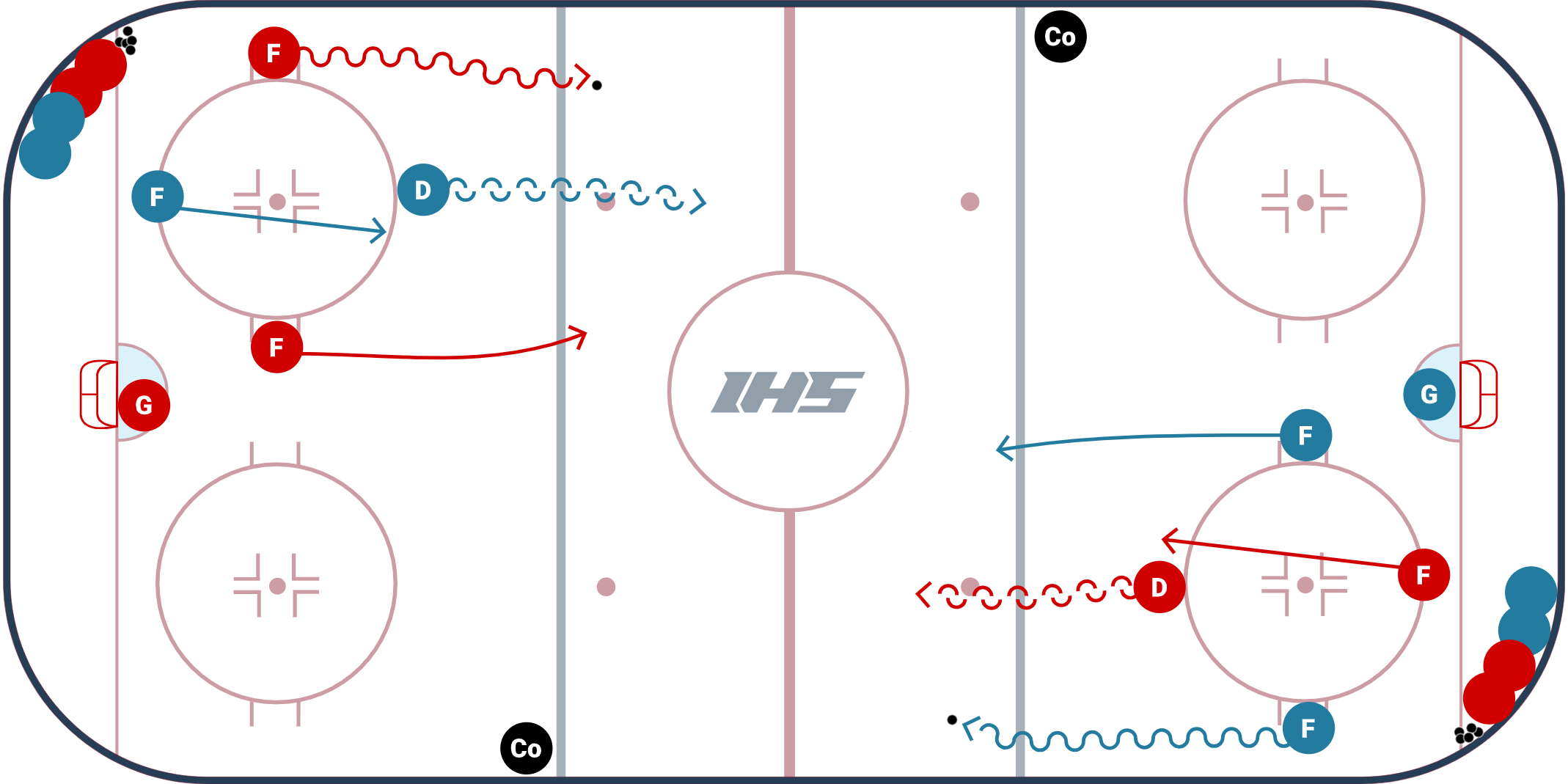
Red Wing 2 V 1 With Backchecker from TJ Manastersky, the Head Coach of Brock University, is a drill that practices 2 v 1 rushes with pressure from a backchecker.
Setup
- 2 offensive players line up on the hashmarks. The defender is at the top of the circle, and the backchecker is at the bottom of the circle.
- On the whistle, both sides start a 2 v 1 with a backchecker.
- Stay on your side of the ice until center ice red line.
- Drill is continuous.
Coaching Points
- Defense: D and backchecking forward need to communicate.
- Forwards: Get up ice quickly and look at opportunity to shoot quick after a pass.
SPEED
Davos Game
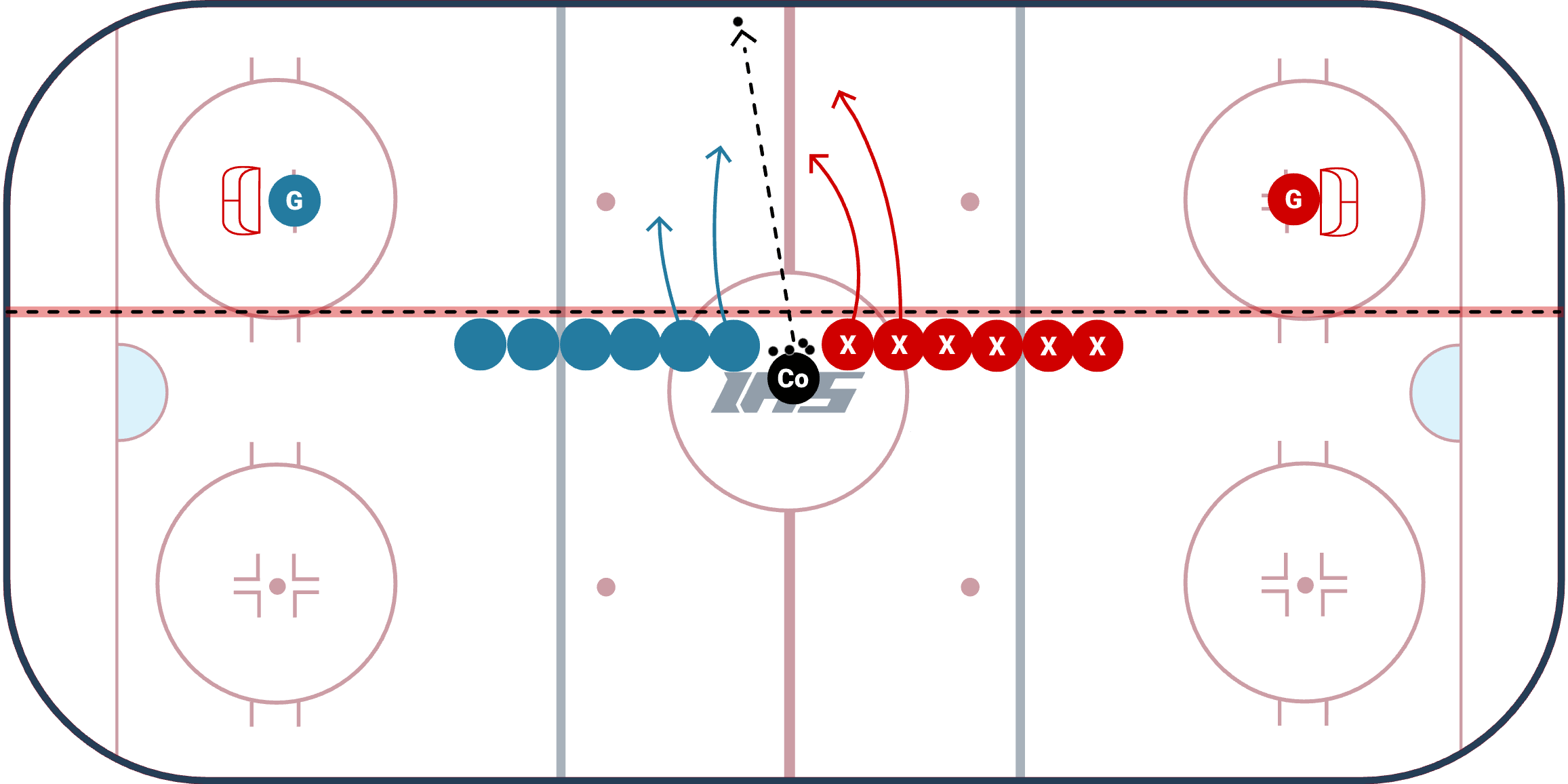
The Davos Game shared by Wes Wolfe is a fresh take on small area games. Instead of playing cross ice, the playing area is set up to be full length, 1/3 ice. There are no rules other than each team is trying to score. The setup and game allows players to think creatively and also use the full length of the ice to skate and pass.
Setup
- Divide the rink up into 1/3 and have players separate and line up at center ice along the boundary (to help keep pucks in).
- On the whistle, a coach chips a puck into the playing area and 2 players from each team race to get the puck, this starts a 2 on 2 game.
- There are NO RULES and no offsides. Players need to work together and think creatively on how they can defend and score.
- If the puck goes out of play, the coach chips in a new puck.
- On the whistle, 2 new players from each team jump in.
Coaching Points
- Plan ahead - coaches should encourage teams to come up with a game plan while they are waiting in line.
- Communicate! With no rules and the ability to go anywhere on the ice, teams need to work together to communicate when they are on the ice.
- Offensive team - try using passes off other boards and area passes to spring a fast break.
- Defensive team - keep sticks on the ice to angle and block passing lanes.
- Goalies - play the puck and look to make passes to your teammates.
Variations
- Can play 2v2, or 3v3.
- Can play with or without offsides.
3 vs. 3 Corner Drill
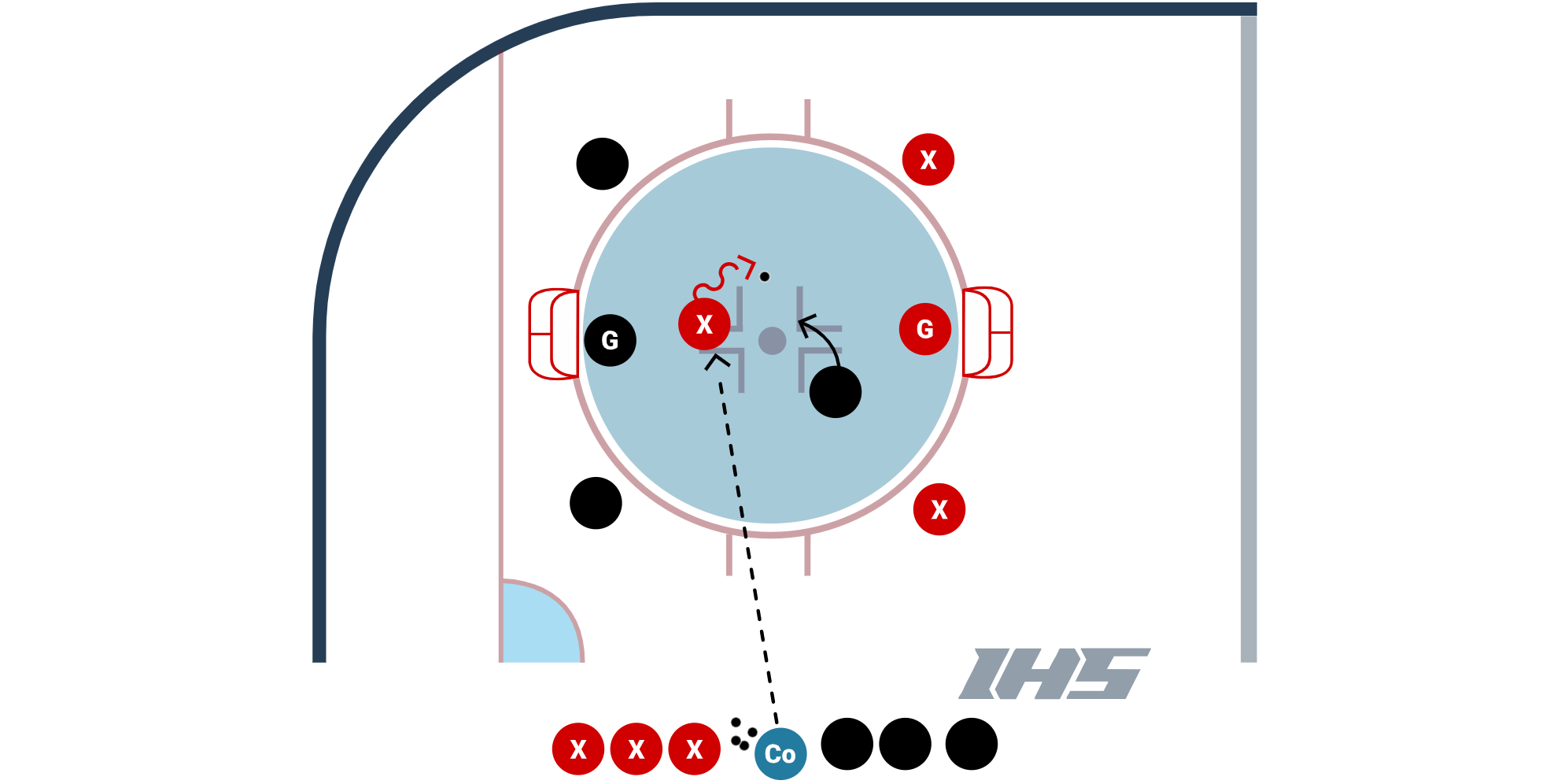
The 3 vs. 3 Corner Drill is a fun game from Topher Scott that helps players develop a scoring mentality. This 3 vs. 3 game has one major constraint: each team is allowed one player that can play inside of the circle. The other teammates must play on the outside of the circle. Communication, quick passing and quick shots will help teams be successful in this game.
Setup:
- It is a 3 vs. 3 game that is played around a circle.
- Two nets are set up on opposite ends of the circle.
- Each team is allowed 1 player inside the circle and their other 2 teammates stay on the outside of the circle.
- The game starts when a coach chips the puck in the circle for a 1v1 battle or the coach can pass to one of the players to start the game.
- The game can be stopped or a new puck can be added when a goal is scored, the puck goes out of play, or the coach blows the whistle.
- Keep score!
Coaching Points:
- Quick shots and quick passes!
- Players without the puck should work to be an outlet for their teammates (get open, call for the puck and present your stick as a target).
- Defensive players should keep their sticks on the ice to block passing lanes.
Angling Through The Circles Progression
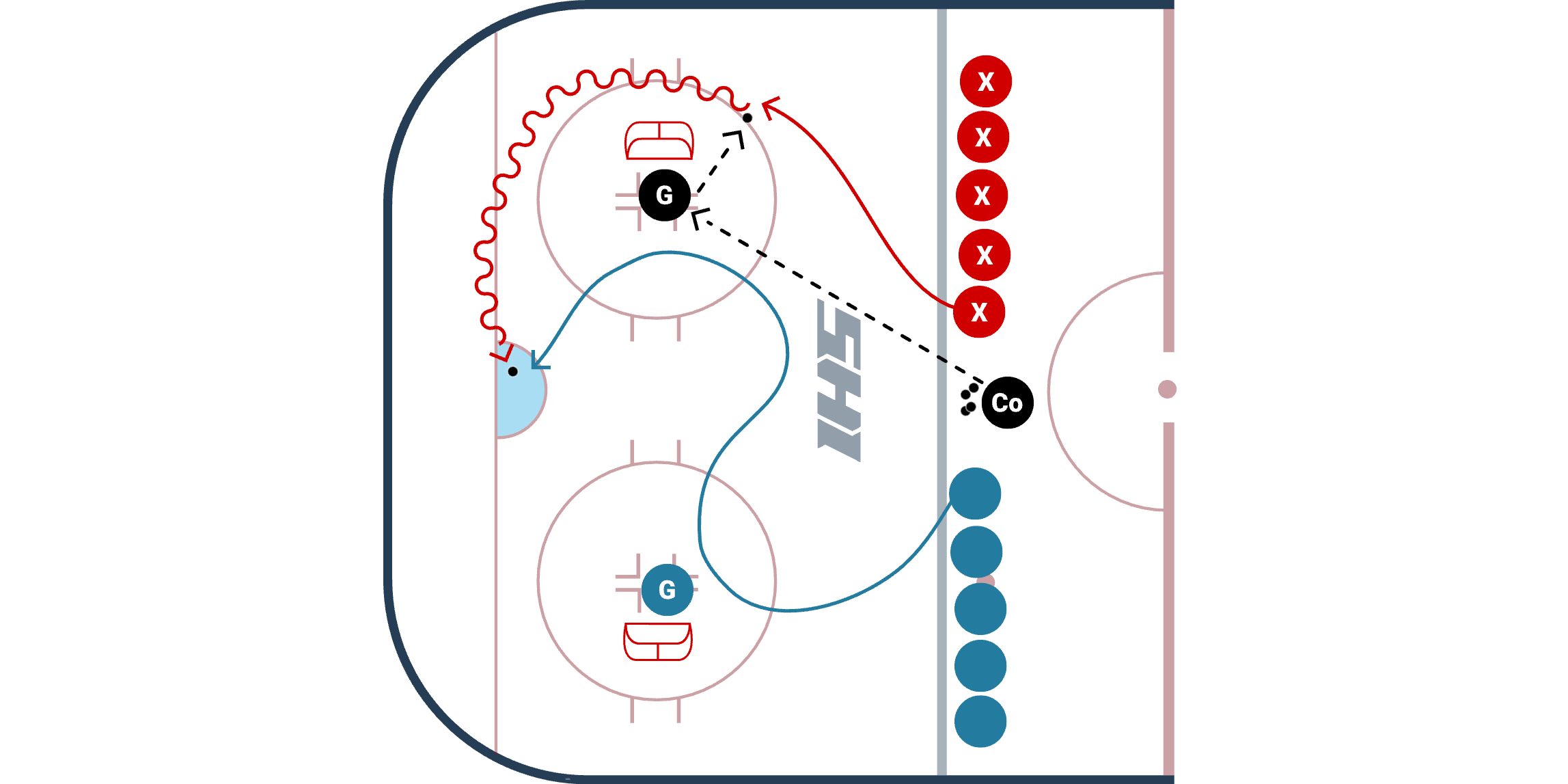
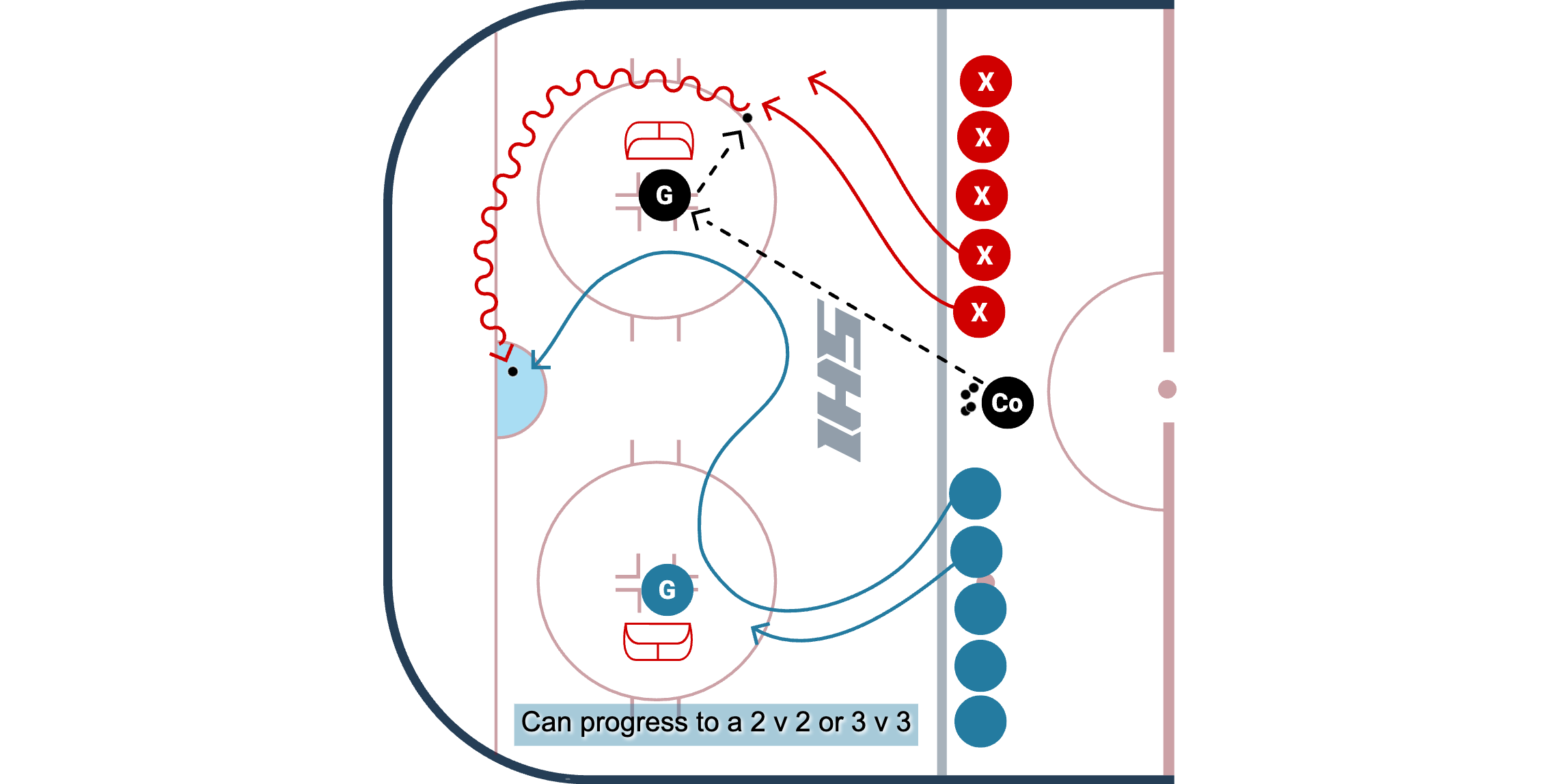
The Angling Through The Circles Progression starts as a 1 v 1, and can progress to a 2 v 2, and 3 v 3. Both teams are trying to score, and work on angling.
Setup
- Place 2 nets in a cross-ice setup.
- Coach puts a puck on a goalie and a player picks it up and wheels around the net and drives toward the opposing net.
- The defending player much go through both circles and angle the other player out of the play.
- The game continues as a 1 v 1 battle.
- The progression starts out as 1 v 1, but can progress to 2 v 2 and 3 v 3.
Coaching Points
- Players that are angling the puck carrier should work to match the puck carriers speed, keep their stick on the ice to go stick on puck, and then eliminate their hands with body contact.
- Supporting players on defense should be ready to jump in for loose pucks to support their teammate, and transition quickly to offense.
Tigers Half Ice Shooting Drill
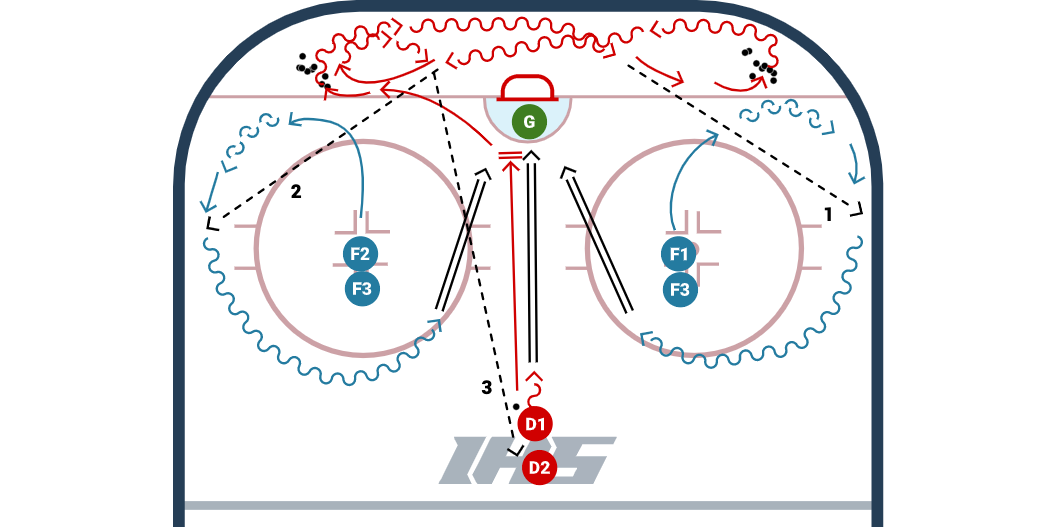
This is a great shooting half ice drill with a lot of good skill elements for defense, forwards, and goalies. It is also a useful drill for half ice situations / pratices. To set up place a line of defense in the middle of the ice at the blue line and a line of forwards at each face off dot as shown in the diagram.
The drill starts with D1 taking a shot from the point and following it to the net for a rebound. After they stop at the net they continue to the corner to get a puck and carry the puck back around the net. While they are picking up the puck F1 curls towards the boards and gets in position to receive a breakout pass from D1. Once they receive the pass they curl into the slot behind the line of fowards and take a shot on net. F1 follows their shot for a rebound and then returns to the end of the line. D1 continues the drill by picking up another puck from the other corner and carrying it around the net to make another outlet pass to F2. F2 does the same thing as F1 on the other side. After D1 makes the second pass they continue to the corner one more time to retrieve a third puck. This time they make a pass out to the blue line to the next defense who starts the drill over again.
Defensive Zone Coverage - Protect the House
Hi. This is Denis Savard of Ice Hockey Systems. Welcome. First of all we are talking about the D-Zone coverage here. One of the key things that’s going to be important for D-Zone coverage is about protecting the house. As you saw up here, I put a little design here where it looks a bit like a house. My artwork is not the best thing in the world but this is what it looks like. So it’s very, very important that we protect this area, and that’s why how we position our guys or whenever D1 and your puck here, F1 is supporting, and whenever D2 -- you follow that. We’re going to have our F2 in this area. We’re going to have our F3 down in the slide area.
This should be our positioning once we get in our zone, wherever, you should be in position. Now, depending on what the other teams are doing, one of the key things that you’re going to see is what their X1, their X2, obviously their X3 would position themselves on top here and be the shooter. You have their D1 and their D2 in this position here.
So right now as we speak, we got pretty much everything covered. If X1 has the puck, obviously we want our defenseman to be on the puck, to be on the opponent on their X1. The quicker the better. And the whole key about this as a defenseman, when you go out and check somebody, you want to make sure that you stick on the puck. You want to disrupt a separation from the puck and their player so your F1 would be able to come in and help and move the puck up maybe to F2 or however, just get it out so we’re on offense. The quicker we are or better defensively, the better we’re going to be on offense.
Now, situations are going to happen where the puck is going to be moved to X2. Pretty simple. There’s a rotation that has to be made now. They will have a D1 that was on this guy here. Now, F1 is on X2 because the puck has been moved. Key situation where D1 is to get back in this position here protecting their net.
Now, the one thin g that we’re going to be talking about too a lot of times is their X3 which is shooter, we want to make sure that our D2 comes out and locates their X3. We know that there is help here with our F2 in case he falls down or any circumstances that could happen. But obviously, D2, your job is to come out and locate X3, denying him to get a shot if that’s the case here and try to move the puck to X3.
Now, a lot of times you see a lot of forwards on D-Zone coverage are going to end up starting to creep up towards the boards when the puck is in the area here. The reason why we don’t want you to keep up along the boards, if I take you up here as an example, you would see how much time and space there is in this area here. And again, we want to protect the house. The house is there for a reason so that’s why we need you in this position here. If the puck is moved to the plank, obviously you want to get in the shooting lane and get out of the defenseman which is an easy task for you to do. And that’s pretty much your responsibility as F2 on the strong side.
F3, if there’s a breakdown down in this area here, that’s why you’re the support guy. You come down and help. And if there -- happened that somebody had fell down, you’re going to help us out in that situation here. At the same time, if they activate your D2, you will be going with it with your D2. That’s your guy all the way through. No matter what he does, you need to cover him to your way to the net.
Now, we talked about also when the puck changes side, we’ll go over this. When we do have a puck that changes side, we got X1 here, we had X2. For some reason X2, he’s got the puck, he’s starting to move. Their X3 start to go all the way out to the other side. Now, pretty simple. We are D1 and the puck originally that was bumped to their X2. Now, their F1 is going at him, our D is starting to return. Puck has changed side. This D2 in front of the net, you cannot leave your area until D1 calls you to go. Remember, once X3 is done in this area here, his chance of scoring from behind the net are pretty slim. Sometimes it’s going to happen the guys throws the puck at the net but we call that a bad goal.
So the thing that’s very important for D2 to know is when your D1 gets back to the front, that releases you to go on to X3. Nothing changes as far as for F1. He comes over and he continues to be the support guy to our defenseman. Our F3, obviously you become the strong side guy helping out and locating where the defenseman is at. Obviously F2 back to the slide area. And D1 that came back to the front, you will then locate their IS guy which will become their X3.
Hopefully that helps you. Thanks for watching.
